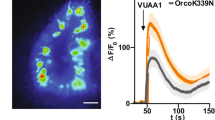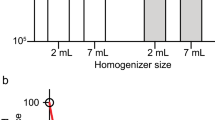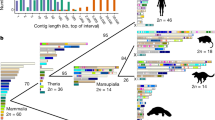Abstract
Behavioural responses of Drosophila melanogaster larvae were measured in response to olfactory stimulation with an homologous series of eight aliphatic n-acetates (methyl…octyl actetate) and with cis-vaccenyl acetate. Larvae tended to be attracted to short-chain acetates (methyl…pentyl) and repelled by longer chain acetates (hexyl, heptyl and octyl acetate). All larvae were strongly attracted to propyl acetate, irrespective of the dose studied. Larval olfactory responses generally declined with age. Two geographical strains showed specific anosmias. Katsunuma (Japan) larvae showed no response to hexyl acetate; chromosome substitution showed this behaviour to be controlled by genes on chromosome II. Tai (Ivory Coast) larvae showed no response to pentyl acetate; chromosome substitution showed that two genetic factors were primarily involved, on the X chromosome and chromosome III. The response was modulated by chromosome II. No effect of the Y chromosome was found. Two olfactory mutants were studied, olfC (X chromosome) and Indf (chromosome III); both mutants showed abnormal responses to certain acetates. The results are discussed in terms of various models of olfactory processing and the implications of these models for the number of genes involved in olfaction.
Similar content being viewed by others
Article PDF
References
Aceves-Pina, E, and Quinn, W. 1979. Learning in normal and mutant Drosophila larvae. Science, 206, 93–96.
Alcorta, E, and Rubio, J. 1988. Genetical analysis of intra-populational variation in olfactory response in Drosophila melanogaster. Heredity, 60, 7–14.
Averill, A L, Reissig, W H, and Roelofs, W L. 1988. Specificity of olfactory responses in the tephritid fruit fly, Rhagoletis pomonella. Entomologia exp appl, 47, 211–222.
Ayyub, C, Paranjape, J, Rodrigues, V, and Siddiqi, O. 1990. Genetics of olfactory behavior in Drosophila melanogaster. J Neurogenen, 6, 243–262.
Bargmann, C I, Hartwieg, E, and Horvitz, H R. 1993. Odorant-selective genes and neurons mediate olfaction in C. elegans. Cell, 74, 515–527.
Barrows, W M. 1907. The reactions of the pomace fly Drosophila ampelophila Loew, to odorous substances. J Exp Zool, 4, 515–537.
Bartelt, R J, Schaner, A M, and Jackson, L L. 1985. Cis-Vaccenyl acetate as an aggregation pheromone in Drosophila melanogaster. J Chem Ecol, 11, 1747–1756.
Bauer, S J, and Sokolowski, M B. 1985. A genetic analysis of path length and pupation height in a natural population of Drosophila melanogaster. Can J Genet Cytol, 27, 334–340.
Berger, R G. 1990. The biogenesis of fruit flavors: a continuing story. Perfumer and Flavorist, 15, 33–39.
Buck, L, and Axel, R. 1991. A novel multigene family may encode odorant receptors: a molecular basis for odor recognition. Cell, 65, 175–187.
Carlson, J. 1991. Olfaction in Drosophila: genetic and molecular analysis. Trends Neurosci, 14, 520–524.
Cobb, M, Bruneau, S, and Jallon, J-M. 1992. Genetic and developmental factors in the olfactory response of Drosophila melanogaster larvae to alcohols. Proc R Soc B, 248, 103–109.
Cobb, M, Venard, R, and Jallon, J-M. 1993. From genes to smell: Studies in olfaction in Drosophila melanogaster. In: Wiese, K., Gribakin, F. G., Popov, A. V. and Renninger G. (eds) Sensory Systems of Arthropods, pp. 462–468. Birkhäuser, Berlin.
Ferveur, J-F, Cobb, M, and Jallon, J-M. 1989. Complex chemical messages in Drosophila. In:Singh, R. N. and Strausfeld, N. J. (eds) Neurobiology of Sensory Systems, pp. 397–409. Plenum, New York.
Fuyama, Y. 1978. Behavior genetics of Drosophila. II. An odorant specific variant in a natural population of Drosophila melanogaster. Behav Genet, 8, 375–405.
Jallon, J-M. 1984. A few chemical words exchanged by Drosophila during courtship. Behav Genet, 14, 441–478.
Lilly, M, and Carlson, J. 1989. smellblind: a gene required for Drosophila olfaction. Genetics, 124, 293–302.
Lindsley, D L, and Zimm, G G. 1992. The Genome of Drosophila melanogaster. Academic Press, London.
Monte, P, Woodard, C, Ayer, R, Lilly, M, Sun, H, and Carlson, J. 1989. Characterization of the larval olfactory response in Drosophila and its genetic basis. Behav Genet, 19, 267–283.
Mori, K, Mataga, N, and Imamura, K. 1992. Differential specificities of single mitral cells in the rabbit olfactory bulb for a homologous series of fatty-acid odor molecules. J Neurophysiol, 67, 786–789.
Ngai, J, Chess, A, Dowling, M M, Necles, N, Macagno, E R, and Axel, R. 1993. Coding of olfactory information: topography of odorant receptor expression in the catfish olfactory epithelium. Cell, 72, 667–680.
Patte, F, Etcheto, M, and Laffort, P. 1982. Solubility factors for 240 solutes and 207 stationary phases in gas-liquid chromatography. Analyt Chem, 54, 2239–2247.
Raming, K, Krieger, J, Strotmann, J, Boekhoff, I, Kubick, S, Baumstark, C, and Breer, H. 1993. Cloning and expression of odorant receptors. Nature, 361, 353–356.
Rodrigues, V. 1980. Olfactory behavior of Drosphila melanogaster. In: Siddiqi, O., Babu, P., Hall, L. M. and Hall, J. C. (eds) Development and Neurobiology of Drosophila, pp. 361–372. Plenum Press, London.
Shepherd, G. 1991. Computational structure of the olfactory system. In: Davis, J. L. and Eichenbaum H. (eds) Olfaction: a Model System for Computational Neuroscience, pp. 3–41. MIT Press, London.
Siddiqi, O. 1983. Olfactory neurogenetics of Drosphila. In:Chopra, V. L., Joshi, B. C, Sharma R. P. and Bansal, H. C. (eds) Genetics: New Frontiers, vol. III, pp. 243–261. Oxford University Press, Bombay.
Siddiqi, O. 1987. Neurogenetics of olfaction in Drosophila melanogaster. Trends Genet, 3, 137–142.
Singh, R N, and Singh, K. 1984. Fine structure of the sensory organs of Drosophila melanogaster Meigen larvae (Diptera: Drosophilidae). Int J Insect Morphol Embryol, 13, 255–273.
Stocker, R. 1994. The organization of the chemosensory system in Drosophila melanogaster. a review. Cell Tissue Res, 275, 3–26.
Tonosaki, K, and Tucker, D. 1982. Olfactory receptor cell responses of dog and box turtle to aliphatic n-acetates and aliphatic n-fatty acids. Behav Neural Biol, 35, 187–199.
Venard, R, and Pichon, Y. 1984. Electrophysiological analysis of the peripheral response to odours in wild type and smell-deficient olf C mutant of Drosophila melanogaster. J Insect Physiol, 30, 1–5.
Woodard, C, Huang, T, Sun, H, Helfand, S L, and Carlson, J. 1989. Genetic analysis of olfactory behavior in Drosophila: a new screen yields the ota mutants. Genetics, 123, 315–326.
Author information
Authors and Affiliations
Rights and permissions
About this article
Cite this article
Cobb, M., Dannet, F. Multiple genetic control of acetate-induced olfactory responses in Drosophila melanogaster larvae. Heredity 73, 444–455 (1994). https://doi.org/10.1038/hdy.1994.192
Received:
Issue date:
DOI: https://doi.org/10.1038/hdy.1994.192
Keywords
This article is cited by
-
Evidence of nanoemulsion as an effective control measure for fruit flies Drosophila melanogaster
Scientific Reports (2019)
-
Prior Exposure to DEET Interrupts Positive and Negative Responses to Olfactory Cues in Drosophila Melanogaster
Journal of Insect Behavior (2015)
-
Genetic Architecture of Olfactory Behavior in Drosophila melanogaster: Differences and Similarities Across Development
Behavior Genetics (2013)



